
In our model of exponential education, our methods of teaching and learning will be scientific in approach and execution.
We’ll understand how children learn, and we will teach using principles, methods and techniques based on observable ways that children and adults learn best.
Our schools will focus on helping children and adults have the tools to lead meaningful lives in their families, communities and beyond.
Running a place for successful learning is not a “fast food” business. We can’t gulp down facts and have them form a foundation for a life well-lived.
Preparing a healthy meal takes time–from planting seeds, weeding, pruning, harvesting, storing, preparing food and finally putting it on the table.
Learning takes time, from the germination of an idea to its fruition.
It takes time to acquire in-depth understanding, long-term retention and command of that knowledge in order to create and problem solve. Optimum learning requires time everyday, for many years. Expertise may require a minimum of 10,000 hours of focused practice.
Learning requires energy fueled by healthy foods with appropriate amounts of sleep and exercise.
Learning requires an environment that is safe and peaceful and nourishes a love of learning.
It is a place where experimentation, questioning and risk are encouraged and accepted. All students want to do well; they need time, and a place with the right people, to attain excellence.
Optimum learning requires that the abstract be made concrete and that big tasks be broken into manageable projects.
Difficulties in learning need to be isolated, and related skills mastered, then added back into the overall picture. For example, if a student is having trouble with place value in addition, lessons and exercises in understanding place value are given until that concept is understood, and then multi-digit addition is reintroduced.
Learning requires loving adult guidance.
Adults–teacher and parent–guide and direct the children’s learning based on each child’s strengths and interests. The sports-loving student might learn multiplication by kicking six soccer balls three times to figure out 18 kicks, and do so much more quickly than writing 6 x 3 = 18 a hundred times. It is the enlightened adult that kindly directs the child’s activities, so learning occurs easily yet profoundly.
Learning requires repetition.
For the child under the age of seven years, doing exactly the same thing over and over aids learning. For the child over the age of seven (about the time the first teeth fall out), repetition must be done with variety. For example, the four-year-old loves to hear the same stories over and over for months. The seven-year-old loves to hear stories but demands a different one every day and professes boredom when hearing a tale twice.
Learning requires being friendly with error.
We learn best from our mistakes, so it is best to be friendly when learning experiments go astray.
The human brain is an amazing machine that comes without an operation manual, or a warranty for that matter.
We do know, through years of observations, that when certain conditions are present–good nutrition, adequate rest, safe learning environments, concrete and meaningful experiences, loving adult guidance, repetition, and friendliness to errors–human beings survive and thrive.
Our ongoing research and understanding of how learning occurs make all the difference in how our children will be able to create a successful life.
This is part of a series about creating a fresh approach to education.
Next: What Does Success Look Like?


4 Responses to “Understanding How Learning Takes Place”